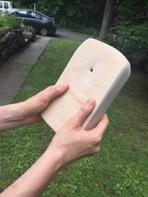
ABOVE Fig. 4. Julianne Swartz, sound object from Transfer (objects), 2017, mixed media, site-specific installation, Sherman Art Library, Dartmouth College, Hanover, New Hampshire. Photo courtesy of Julianne Swartz.
Julianne Swartz: Transfer (objects)
Julianne Swartz approaches sound as a material, like paint, wood, or metal. She describes sound as a “heavy” material when present in an artwork, since it often dominates the visual elements accompanying it.11 Swartz attempts to create work balancing visual and sonic elements both in a self-contained way within the artwork, and within the environment where they are situated, since loudness of sound in sound art is in a sense comparable to intensity of light and color in the visual domain.
Site specificity is central to many of Swartz’s past works and is expressed again in Transfer (objects) (2017), installed in Dartmouth’s Sherman Art Library. For the context of a university library possessed by a special decorum that combines silence with study and thought, Swartz conceived a suite of sound-emitting objects that attempt to encapsulate the virtues and qualities of the library environment itself.
As described in the exhibition didactic: “Building on the qualities and expectations of the library, Swartz created three listening objects that resemble books in scale, weight, and location (fig. 4). They are meant to be held and listened to by one person at a time, and this one-on-one relationship dictates the objects’ form and function. The sound is a private, singular experience that echoes the act of reading.”12 Yet, the wooden objects are striking in how nondescript, almost formless they are. With soft edges that appear more like clay than wood, the objects do not suggest by their appearance that they make sound, yet they invite visitors to hold and interact with them. In this manner the objects simultaneously connect wood, the essential substance of books, with clay and its alignment with the creation of the human form. The softness extends to the tactile experience of the objects through many hours of sanding and shaping. Together, these elements point toward the essence of the work as intrinsically about the phenomenological human experience.
The objects each possess a small hole in the upper half of the form allowing sound to escape. Swartz was careful to balance the loudness of sound so as not to damage a visitor’s hearing, while permitting the listener to discern sonic materials consisting of writing and murmuring sounds that at times reference specific passages from books Swartz installed alongside the objects. The result is a soothing and introspective experience for the listener akin to the kind of interiority and stillness suggested by Wheeler’s Synthetic Desert, only it is miniaturized. These are not visually or sonically “loud” objects, but instead possess a kind of constrained blankness, which is a trope of perceptual minimalism in the sense that not one element is more important than the other, and that the sounds of writing provide an essentially uneventful yet soothing, ASMR-like experience.13 Perhaps more importantly, the objects are created with the intent to cohabitate with the books, sounds, and conditions around them. They are as much intended to be participants within the environment as they are to focus the mind on the very essence of reading and writing.